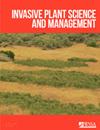Identifying the geographic origins of invasive Megathyrsus maximus in the United States using molecular data
IF 1.2
4区 生物学
Q3 PLANT SCIENCES
引用次数: 0
Abstract
Abstract Megathyrsus maximus is nonnative in the neotropics, with a tall form that is commonly used as a forage grass and a smaller-statured form that is considered invasive in south Texas, USA. Biological control researchers are challenged to find an agent that will attack the short form, but not the desirable tall form in other parts of the neotropics. We conducted molecular analyses on 155 Megathyrsus maximus samples from its native range in Africa and compared them with U.S. short-form samples to help determine the geographic origins of its invasion. We found eight distinct genotypes in 34 short-form samples from Texas and Florida, USA. The highest genetic similarity of invasive samples was with plants from South Africa, while highest matches for the desirable tall form were from Kenya, Uganda, Ivory Coast, and Zambia. Ongoing biological control agent exploration and research has found agents from Kenya that are associated with an M. maximus genotype not well matched to the invasive short form, thus leading to a lack of rearing success. Two eriophyoid mite agents from the genetic match locality in South Africa have been evaluated but are not sufficiently host specific, as they develop on both the short and tall forms. Additional exploration is needed at the genetic match populations in South Africa to discover and evaluate potential biological control agents for the invasive form of M. maximus.利用分子数据确定美国入侵性大鼠的地理起源
摘要Megathyrsus maximus是新热带地区的非本地物种,其高大的体型通常被用作饲草,而较小的体型被认为是美国得克萨斯州南部的入侵物种。生物控制研究人员面临的挑战是找到一种能攻击矮小体型的药剂,但在新热带地区其他地区却不是理想的高大体型。我们对来自非洲本土的155个大冠病毒样本进行了分子分析,并将其与美国的短型样本进行了比较,以帮助确定其入侵的地理起源。我们在来自美国得克萨斯州和佛罗里达州的34个短型样本中发现了8种不同的基因型。入侵样本的遗传相似性最高的是来自南非的植物,而与理想的高型最匹配的是来自肯尼亚、乌干达、象牙海岸和赞比亚。正在进行的生物控制剂探索和研究发现,来自肯尼亚的与M.maximus基因型相关的药剂与入侵性短型不太匹配,从而导致饲养缺乏成功。已经评估了来自南非基因匹配地区的两种类脂螨剂,但它们在矮型和高型上都有发育,因此对宿主的特异性不够。需要在南非的基因匹配种群中进行进一步的探索,以发现和评估入侵型M.maximus的潜在生物控制剂。
本文章由计算机程序翻译,如有差异,请以英文原文为准。
求助全文
约1分钟内获得全文
求助全文
来源期刊

Invasive Plant Science and Management
PLANT SCIENCES-
CiteScore
2.20
自引率
9.10%
发文量
24
审稿时长
6-12 weeks
期刊介绍:
Invasive Plant Science and Management (IPSM) is an online peer-reviewed journal focusing on fundamental and applied research on invasive plant biology, ecology, management, and restoration of invaded non-crop areas, and on other aspects relevant to invasive species, including educational activities and policy issues. Topics include the biology and ecology of invasive plants in rangeland, prairie, pasture, wildland, forestry, riparian, wetland, aquatic, recreational, rights-of-ways, and other non-crop (parks, preserves, natural areas) settings; genetics of invasive plants; social, ecological, and economic impacts of invasive plants and their management; design, efficacy, and integration of control tools; land restoration and rehabilitation; effects of management on soil, air, water, and wildlife; education, extension, and outreach methods and resources; technology and product reports; mapping and remote sensing, inventory and monitoring; technology transfer tools; case study reports; and regulatory issues.
 求助内容:
求助内容: 应助结果提醒方式:
应助结果提醒方式:


